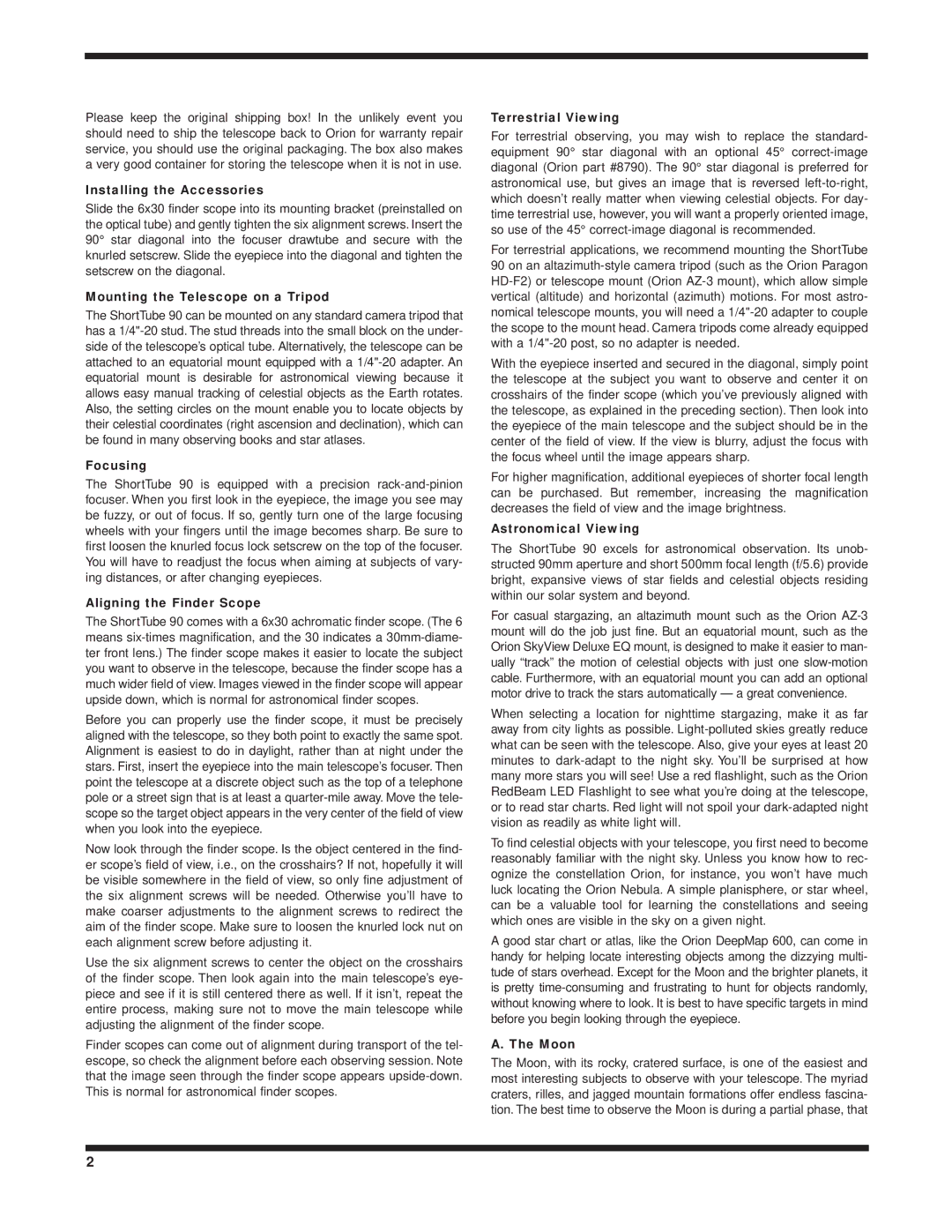
Please keep the original shipping box! In the unlikely event you should need to ship the telescope back to Orion for warranty repair service, you should use the original packaging. The box also makes a very good container for storing the telescope when it is not in use.
Installing the Accessories
Slide the 6x30 finder scope into its mounting bracket (preinstalled on the optical tube) and gently tighten the six alignment screws. Insert the 90° star diagonal into the focuser drawtube and secure with the knurled setscrew. Slide the eyepiece into the diagonal and tighten the setscrew on the diagonal.
Mounting the Telescope on a Tripod
The ShortTube 90 can be mounted on any standard camera tripod that has a
Focusing
The ShortTube 90 is equipped with a precision
Aligning the Finder Scope
The ShortTube 90 comes with a 6x30 achromatic finder scope. (The 6 means
Before you can properly use the finder scope, it must be precisely aligned with the telescope, so they both point to exactly the same spot. Alignment is easiest to do in daylight, rather than at night under the stars. First, insert the eyepiece into the main telescope’s focuser. Then point the telescope at a discrete object such as the top of a telephone pole or a street sign that is at least a
Now look through the finder scope. Is the object centered in the find- er scope’s field of view, i.e., on the crosshairs? If not, hopefully it will be visible somewhere in the field of view, so only fine adjustment of the six alignment screws will be needed. Otherwise you’ll have to make coarser adjustments to the alignment screws to redirect the aim of the finder scope. Make sure to loosen the knurled lock nut on each alignment screw before adjusting it.
Use the six alignment screws to center the object on the crosshairs of the finder scope. Then look again into the main telescope’s eye- piece and see if it is still centered there as well. If it isn’t, repeat the entire process, making sure not to move the main telescope while adjusting the alignment of the finder scope.
Finder scopes can come out of alignment during transport of the tel- escope, so check the alignment before each observing session. Note that the image seen through the finder scope appears
Terrestrial Viewing
For terrestrial observing, you may wish to replace the standard- equipment 90° star diagonal with an optional 45°
For terrestrial applications, we recommend mounting the ShortTube 90 on an
With the eyepiece inserted and secured in the diagonal, simply point the telescope at the subject you want to observe and center it on crosshairs of the finder scope (which you’ve previously aligned with the telescope, as explained in the preceding section). Then look into the eyepiece of the main telescope and the subject should be in the center of the field of view. If the view is blurry, adjust the focus with the focus wheel until the image appears sharp.
For higher magnification, additional eyepieces of shorter focal length can be purchased. But remember, increasing the magnification decreases the field of view and the image brightness.
Astronomical Viewing
The ShortTube 90 excels for astronomical observation. Its unob- structed 90mm aperture and short 500mm focal length (f/5.6) provide bright, expansive views of star fields and celestial objects residing within our solar system and beyond.
For casual stargazing, an altazimuth mount such as the Orion
When selecting a location for nighttime stargazing, make it as far away from city lights as possible.
To find celestial objects with your telescope, you first need to become reasonably familiar with the night sky. Unless you know how to rec- ognize the constellation Orion, for instance, you won’t have much luck locating the Orion Nebula. A simple planisphere, or star wheel, can be a valuable tool for learning the constellations and seeing which ones are visible in the sky on a given night.
A good star chart or atlas, like the Orion DeepMap 600, can come in handy for helping locate interesting objects among the dizzying multi- tude of stars overhead. Except for the Moon and the brighter planets, it is pretty
A. The Moon
The Moon, with its rocky, cratered surface, is one of the easiest and most interesting subjects to observe with your telescope. The myriad craters, rilles, and jagged mountain formations offer endless fascina- tion. The best time to observe the Moon is during a partial phase, that
2
